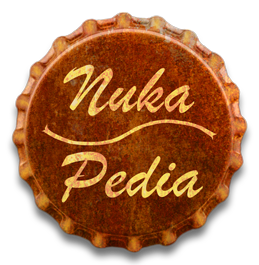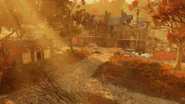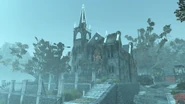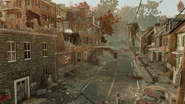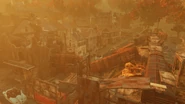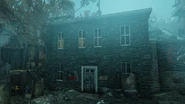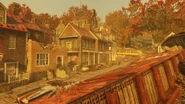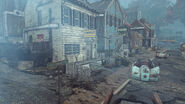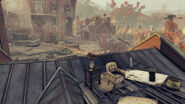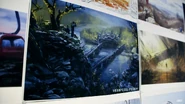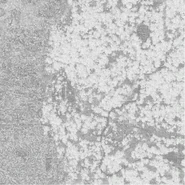Cleanup (Issue: in-game sources for real world history? divergence is possible)
To meet Nukapedia's quality standards, this article or section may require cleanup. Please help by improving the article.
|
Harpers Ferry is a town in the Mire region of Appalachia in 2102.
Background
Historically, Harpers Ferry was a vital junction point for travel across the Potomac and Shenandoah Rivers. The natural confluence of the two rivers led to the establishment of a ferry connecting the two shores, and eventually the foundation of a settlement in 1763, called Shenandoah Falls at Mr Harpers Ferry. The town steadily developed, with major expansions including the United States Armory and Arsenal in 1799, which together with the Springfield Armory in Massachussetts became the primary supplier of small arms. The town grew and prospered until the beginning of the American civil War. John Brown's raid on the arsenal in 1859 was the beginning of a streak of bad luck for the town. Although the abolitionist was tried for treason and hanged, his attempt to touch off a slave uprising captured the imagination of the nation. When the Civil War erupted, Harpers Ferry suffered greatly due to its strategic location on the railroad map and at the mouth of the Shenandoah Valley. The warring between Union and Confederate forces between 1861 and 1865 reduced the town to near ruin, as it changed hands eight times and was the site of bitter fighting that included the largest surrender of U.S. soldiers to a hostile power until the Battle of Bataan, 80 years later. The town did not recover fully due to the changing economy and industryscape of the United States, becoming primarily a historical attraction.[1]
In the decades leading to the Great War, Harpers Ferry became a focal point of the Free States movement. Skeptical of the intentions of the United States government, the Free Staters used the town as a staging area and supply point for the bunkers they were building deep within the Mire. As Harpers Ferry was a small town that depended on tourism, this put them at odds with the growing movement, whose conspiracy theories put off patriotic visitors.[2] It also endangered what few lucrative contracts the town had with larger corporations, such as Med-Tek, which used Harpers Ferry as a proving ground for their Sympto-Matic automated medical unit from September 2076 onwards.[3]
The situation steadily escalated as the Sino-American War deteriorated. In late 2076, the Free Staters started buying up supplies at stores throughout the Ferry, ranging from canned goods to camping gear. Although the shopkeepers found it a little strange, they paid in cash and that was all that mattered (although it did scare some of them when they realized just how much ammunition the Free Staters were buying up).[4] The situation rapidly deteriorated in early 2077, as the divide between the Free Staters and the denizens of Harpers Ferry grew. Street fights between Staters and "patriots" became disturbingly common, tearing the Ferry apart and attracting government attention.[5] At first, the interest was limited to surveillance and documenting Free States membership and their associates. Secret policemen visited Ferry vendors and coerced them into handing over names and addresses, winning a battle and losing the war, as the shopkeepers started to realize that the Free Staters may, in fact, be right about the government.[6] However, the visits also had a notable chilling effect, as by May, many started outright refusing to provide services to Free States members.[7]
By June, the United States military seized on the resentment and launched a propaganda campaign against the Free States, and following up with seizure of property belonging to known members of the movement. Although the signs referred to them as being seized for seditious activity, the propaganda posters left no doubts as to who was the intended target.[8] The piece de resistance came midway through June, when the public prosecutor pressed charges against Raleigh Clay, the leader of the movement.[9] In response, the Free States openly seceded from the United States and by September 2077, completely isolated themselves from the outside world, waiting for the bombs to drop. The military, lacking the resources to fight a protracted counter-insurgency campaign, decided to let them be for the time being.[10]
When the bombs did come, Harpers Ferry was largely abandoned in the turmoil, as emergency services and local survivors struggled to cope with the influx of refugees. The town did not experience a rebirth until the Free States emerged from their bunkers around July 2079. They retook Harpers Ferry and started intense rebuilding efforts, turning it into a major fortress and trading post near the heart of the Mire. Using salvage and scrap gathered from the surrounding area, they established fortifications to protect themselves and people under their care - many of whom formerly despised them for their convictions - from the encroaching mutations.[11] By 2084, the town was a prosperous outpost, providing support and food to those in need. The Free States cooperated closely with the Brotherhood, despite Clay's misgivings about Taggerdy and her outfit.[12]
The Grafton Dam outpost in particular shielded their western flank and allowed traders and travelers to move safely through the Savage Divide to the Ferry. It was also a key route connecting the Free States with the Responders in Charleston, at least until the town was destroyed by raiders in 2082.[13] However, this prosperity would not last. The situation deteriorated after the release of the scorchbeasts by President Thomas Eckhart. The monstrosities wreaked havoc on the region, bringing the Scorched plague in their wake. Harpers Ferry held out until 2086.[14] After the scorchbeasts breached the automated AAA perimeter and started spreading out into adjacent regions, Harpers Ferry was hit hard and fast, wiping it out and forcing the Free Staters back into their reinforced bunkers. Raleigh Clay issued a general order banning all recovery efforts.[15]
Layout
At the outskirts of the town is an armory aligned with the Free States. The town itself is encircled by a wall made from scrap with several container box gates. A dominant feature of the town is a church with several workbenches.
The river to the northeast of town can be crossed by using a railroad/highway bridge which leads into a tunnel. However, the tunnel has evidently caved in; one cannot pass through it to the other side. The tunnel contains highly radioactive containers and a railroad car containing a sizable amount of loot. At the mouth of the tunnel is a wooden walkway leading under the bridge and to a path between the cliff and the water which leads to the ransacked bunker.
Points of interest
- Harpers Ferry is a large town with densely packed residential buildings and a myriad of blind spots. It can be roughly divided into two sections: The fortress, built on the hill surrounding St. Peter's Roman Catholic Church (the neo-gothic building was converted into barracks), and the outer areas, bounded by the state route in the west and the railways to the north-east and south-east.
- The outer areas consist primarily of townhouses in the northern and eastern section, with John Brown's "Fort" (19th century firehouse) in the east, where Brown made a stand and was captured in 1859. It has been turned into a museum with numerous civil war-era items
- Harper's Ferry armory is to the south. The armory requires an access code and contains a plethora of weapons, a steamer trunk, and three workshops (weapons, armor, and tinkering). Potomac Street running northwest to southeast in the northeast part of the town is also part of the outer ring.
- Outside the fortifications are two manhole covers (North and South) leading to the Burrows.
- There is a trading post at the northern edge of town, at the northern end of Shenandoah Street, just behind the buildings. It contains a vendor bot for the Free States and a chemistry station.
- Inside Harpers fortifications navigation can get confusing, due to the packed environment and passages between houses. At any rate, major points of interest include:
- The Harpers Ferry clinic, by the southeastern gate. The bottom floor contains the medical lab and storage, along with a plethora of chems. There is, however, a pressure plate at the bottom of the stairs that releases a grenade bouquet.
- The aforementioned St. Peter's church, which makes for a useful landmark and scavenging spot, which contains the Free States barracks and another two workbenches for weapons and armor. Just north of it is a small garden with a cooking station.
- A dead vault dweller is sitting on an upstairs sofa.
Notable loot
- Random weapon plan - To the right of the weapons workbench inside the church, on a makeshift metal table.
- A significant number of chems can be found in the basement of the clinic.
- Holotapes and notes
- All five Lydia's journal pages - For locations, see page.
- A safe haven - Holotape, found on a desk in the same house as Lydia's journal page 20.
- Restoring order - Holotape, next to the north gate terminal.
- Ella's log: Harpers Ferry - On a table inside the church.
- Harpers Ferry postcard - Obtained during the quest A Mark in the Past - Harpers Ferry.
- Sharon's angry letter - On a desk in the church.
- Leonard's journal entry - Note, found upstairs in the building next to the clinic, beside several flasks and test tube racks.
- Jesus Sunday's holotape - Part 1 - On a table on the roof of house #402.
- Jesus Sunday's holotape - Part 2 - Holotape, found next to the south gate terminal by the clinic.
- Fortifications key - On a table in the middle of the church. Opens various doors.
- Letter of resignation - On the second floor desk of the clinic.
- Being followed - Note, in a cooler on the river northeast of Harpers Ferry.
- C.H. Monthly, October - Found on the ground floor of a house (#106).
- Three random armor plans
- Inside an open display case, on the first floor, facing the northwestern wall, at house #394.
- Inside an open square display case, on the third floor, next to a bathroom, at house #394.
- To the left of the armor workbench inside the church, on a metal barrel.
- Two random recipes
- Inside an open display case, facing the northwestern wall, on the third floor, at house #394.
- On a set of lockers shelf, on the third floor, at house #106.
Appearances
Harpers Ferry appears only in Fallout 76.
Behind the scenes
Harpers Ferry is based on the real-world Harpers Ferry, situated where the Shenandoah River flows into the Potomac River. Although Harpers Ferry is located on the border with Virginia and Maryland, far from the game's other major locations, it was moved over to fit into the map as the game developers wished to include it in the game.[16]
Gallery
References
- ↑ Real-life history
- ↑ Fallout 76 loading screen hints
- ↑ Harpers Ferry terminal entries#Med-Tek Sympto-Matic Terminal
- ↑ Harpers Ferry terminal entries#11.16.76
- ↑ Harpers Ferry terminal entries#01.01.77
- ↑ Harpers Ferry terminal entries#03.20.77
- ↑ Harpers Ferry terminal entries#The Carson Family
- ↑ Charleston Capitol Building terminal entries#Subject: No Luck
- ↑ Charleston Capitol Building terminal entries#Subject: Advice
- ↑ Sugar Grove terminal entries#10-13-77: Free States
- ↑ Charleston Capitol Building terminal entries#They've left their bunkers
- ↑ Sam Blackwell's bunker terminals
- ↑ Raleigh Clay's bunker terminal entries
- ↑ Abbie's bunker terminal entries#Day One
- ↑ Free State notifications: "-----------------------------------------------------
To all:
I'm not sure how many people this will reach after the attack on Harpers Ferry. But rest assured, we are working hard on a solution for this new threat.
From the Brotherhood's last transmission, we know we're on our own, and we know their reports were real.
All we can advise for now is to remain in what shelters you may have found, and, if you must leave, stay under as much cover as possible.
- Raleigh" - ↑ The Making of Fallout 76 - Noclip Documentary
